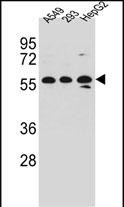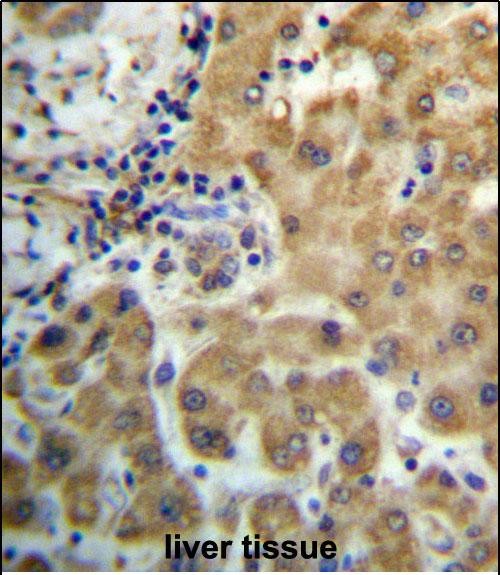TRIM4 Antibody (N-term)
Affinity Purified Rabbit Polyclonal Antibody (Pab)
- SPECIFICATION
- CITATIONS: 1
- PROTOCOLS
- BACKGROUND

Application
| IHC-P, WB, E |
|---|---|
| Primary Accession | Q9C037 |
| Other Accession | NP_148977.2, NP_149082.1 |
| Reactivity | Human |
| Host | Rabbit |
| Clonality | Polyclonal |
| Isotype | Rabbit IgG |
| Calculated MW | 57461 Da |
| Antigen Region | 112-141 aa |
| Gene ID | 89122 |
|---|---|
| Other Names | E3 ubiquitin-protein ligase TRIM4, 632-, RING finger protein 87, Tripartite motif-containing protein 4, TRIM4, RNF87 |
| Target/Specificity | This TRIM4 antibody is generated from rabbits immunized with a KLH conjugated synthetic peptide between 112-141 amino acids from the N-terminal region of human TRIM4. |
| Dilution | IHC-P~~1:10~50 WB~~1:1000 E~~Use at an assay dependent concentration. |
| Format | Purified polyclonal antibody supplied in PBS with 0.09% (W/V) sodium azide. This antibody is purified through a protein A column, followed by peptide affinity purification. |
| Storage | Maintain refrigerated at 2-8°C for up to 2 weeks. For long term storage store at -20°C in small aliquots to prevent freeze-thaw cycles. |
| Precautions | TRIM4 Antibody (N-term) is for research use only and not for use in diagnostic or therapeutic procedures. |
| Name | TRIM4 |
|---|---|
| Synonyms | RNF87 |
| Function | E3 ubiquitin-protein ligase. Mediates 'Lys-63'-linked polyubiquitination of the innate immune receptor RIGI, this linkage doesn't lead to proteasomal degradation but seems to enhance IFN induction. |
| Cellular Location | Cytoplasm. |

Provided below are standard protocols that you may find useful for product applications.
Background
The protein encoded by this gene is a member of the tripartite motif (TRIM) family. The TRIM motif includes three zinc-binding domains, a RING, a B-box type 1 and a B-box type 2, and a coiled-coil region. The protein localizes to cytoplasmic bodies. Its function has not been identified. Alternatively spliced transcript variants that encode different isoforms have been described.
References
Kasyapa, C., et al. Proteomics 9(16):3979-3988(2009)
Li, X., et al. Virology 360(2):419-433(2007)
Thompson, E.E., et al. Pharmacogenomics J. 6(2):105-114(2006)
Reymond, A., et al. EMBO J. 20(9):2140-2151(2001)
If you have used an Abcepta product and would like to share how it has performed, please click on the "Submit Review" button and provide the requested information. Our staff will examine and post your review and contact you if needed.
If you have any additional inquiries please email technical services at tech@abcepta.com.














 Foundational characteristics of cancer include proliferation, angiogenesis, migration, evasion of apoptosis, and cellular immortality. Find key markers for these cellular processes and antibodies to detect them.
Foundational characteristics of cancer include proliferation, angiogenesis, migration, evasion of apoptosis, and cellular immortality. Find key markers for these cellular processes and antibodies to detect them. The SUMOplot™ Analysis Program predicts and scores sumoylation sites in your protein. SUMOylation is a post-translational modification involved in various cellular processes, such as nuclear-cytosolic transport, transcriptional regulation, apoptosis, protein stability, response to stress, and progression through the cell cycle.
The SUMOplot™ Analysis Program predicts and scores sumoylation sites in your protein. SUMOylation is a post-translational modification involved in various cellular processes, such as nuclear-cytosolic transport, transcriptional regulation, apoptosis, protein stability, response to stress, and progression through the cell cycle. The Autophagy Receptor Motif Plotter predicts and scores autophagy receptor binding sites in your protein. Identifying proteins connected to this pathway is critical to understanding the role of autophagy in physiological as well as pathological processes such as development, differentiation, neurodegenerative diseases, stress, infection, and cancer.
The Autophagy Receptor Motif Plotter predicts and scores autophagy receptor binding sites in your protein. Identifying proteins connected to this pathway is critical to understanding the role of autophagy in physiological as well as pathological processes such as development, differentiation, neurodegenerative diseases, stress, infection, and cancer.


